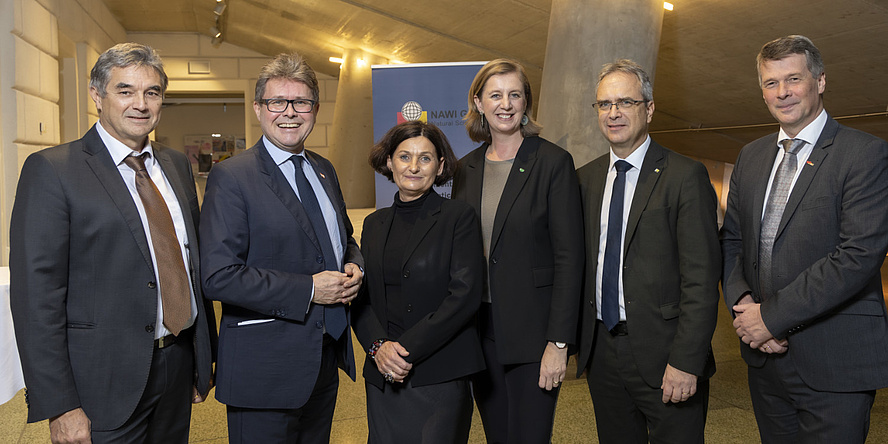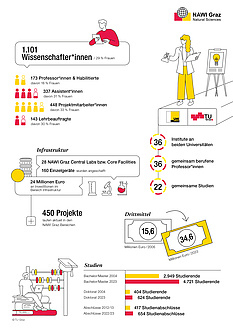20 years ago, the University of Graz and Graz University of Technology (TU Graz) founded the strategic partnership NAWI Graz to bring together scientific research and study programmes in the geosciences, physics, chemistry, biosciences and mathematics. NAWI Graz has not only eliminated duplicate structures and utilised synergy effects, but has also made possible unique projects, such as the construction of the Graz Center of Physics. More than 200 invited guests celebrated the 20th anniversary of this unique Austrian partnership last Friday at TU Graz. In addition to Federal Minister Martin Polaschek and Styrian State Minister for Science Barbara Eibinger-Miedl, the guests included the two founding fathers of NAWI Graz, Hans Sünkel and Alfred Gutschelhofer, as well as university staff from all departments and students of the NAWI Graz cooperation subjects.
“NAWI Graz has been an impressive success story for 20 years. What once began as a vision now has a lasting impact on our science and innovation location. During these two decades, Graz has developed an international reputation for excellence in the natural sciences. The key to success lies in interdisciplinary research and teaching as well as in the optimal utilisation of the strengths of both universities,” emphasises TU Graz Rector Horst Bischof. “We will continue on this successful path in the future.”
“Today, the success of NAWI Graz proves that it was not only right to focus on cooperation instead of competition, but was above all very future-orientated and smart. Together, we have not only improved student support, utilised research infrastructure efficiently and initiated joint research projects, but the alliance between the two universities has also made possible visionary projects such as the Graz Center of Physics, which is currently under construction and will be a centre for interdisciplinary research and the promotion of young talent from 2030,” says Peter Riedler, Rector of the University of Graz, confirming the long-standing cooperation between the University of Graz and TU Graz.
Federal Minister Martin Polaschek is delighted along with the NAWI Graz community: “The twenty-year success story of NAWI Graz is an impressive example of how the partnership-based cooperation between two successful Austrian universities can raise our science and innovation potential to a completely new level. The University of Graz and Graz University of Technology are thus setting national and international standards through joint research, teaching and innovation. This important cooperation is a driving force for the further development of our universities and a significant contribution to strengthening our science and innovation location. I would like to congratulate NAWI on its anniversary, thank all those who have implemented and promoted the project and look forward to many more years of joint success.”
“Styria has enjoyed an outstanding climate of cooperation for many years. This culture of cooperation is key to our role as Europe's leading centre for research and innovation. NAWI Graz is a beacon of cooperation at university level in Styria and has impressively demonstrated over the past 20 years what can be achieved by joining forces,” said Barbara Eibinger-Miedl, Styrian State Minister for Science and Research.
Joint research and targeted investment
Successful research requires the necessary equipment and laboratories and NAWI Graz therefore promotes cooperatively used research infrastructure. Research is currently being conducted in 28 “central labs” (central labs pool thematically related equipment in one place) and core facilities (individual large-scale appliances that several research groups need) in accordance with international standards; around 160 appliances have been purchased and utilised in partnership. The joint commitment is also reflected in successful project acquisitions. The 36 institutes involved in the NAWI Graz cooperation project raised 34.6 million euros in third-party funding in 2023, which corresponds to an increase of around 120 per cent since 2006. Joint NAWI Graz professorial appointments have also become common practice. To date, 36 professors have been appointed in a shared procedure.
Synergies in teaching
Joint studies formed the basis for success. In the cooperation subjects, NAWI Graz now offers 22 degree programmes in biosciences, chemistry, mathematics, physics as well as earth, space and environmental sciences, including six bachelor’s and 16 master’s degree programmes as well as a joint doctoral programme. Around 5,000 students make use of this broad spectrum. Synergies in teaching also lead to a better supervision ratio and the increased quality of the training is also reflected in the number of graduates. In the last 10 years, the number of degrees has increased by almost 55 per cent to 664 in 2023/2024. Since the start of the joint study programme, there have been over 8,500 graduates.
A shared path into the future
The NAWI Graz network is considered a flagship project throughout Austria and shows how the alliance between two universities can work despite different organisational structures. With the construction of the Graz Center of Physics (GCP), cooperation has now been taken to a new level. The ground-breaking ceremony for this inter-university centre, which will unite the physics institutes of TU Graz and the University of Graz from 2030, took place in June 2024. The Graz Center of Physics is currently one of the largest university construction projects in Austria. In addition to the GCP, which is currently being built on the University of Graz campus, four other institutes of TU Graz and the University of Graz will also work together even more closely with each other in the NAWI Graz Geo Center (planned for Campus Inffeldgasse). In this centre, synergies from geology and geotechnics are to be used in the best possible way.
NAWI Graz in figures
36 institutes at both universities
1,101 academics and scientists
173 professors & habilitated researchers, including 36 jointly appointed professors
337 research assistants
448 project staff
450 research projects
34.6 million euros in third-party funds raised (2023)
28 NAWI Graz central labs and core facilities
22 joint study programmes
4,721 students (2023)
624 doctoral students (2023)
664 degrees awarded (2023/2024)

